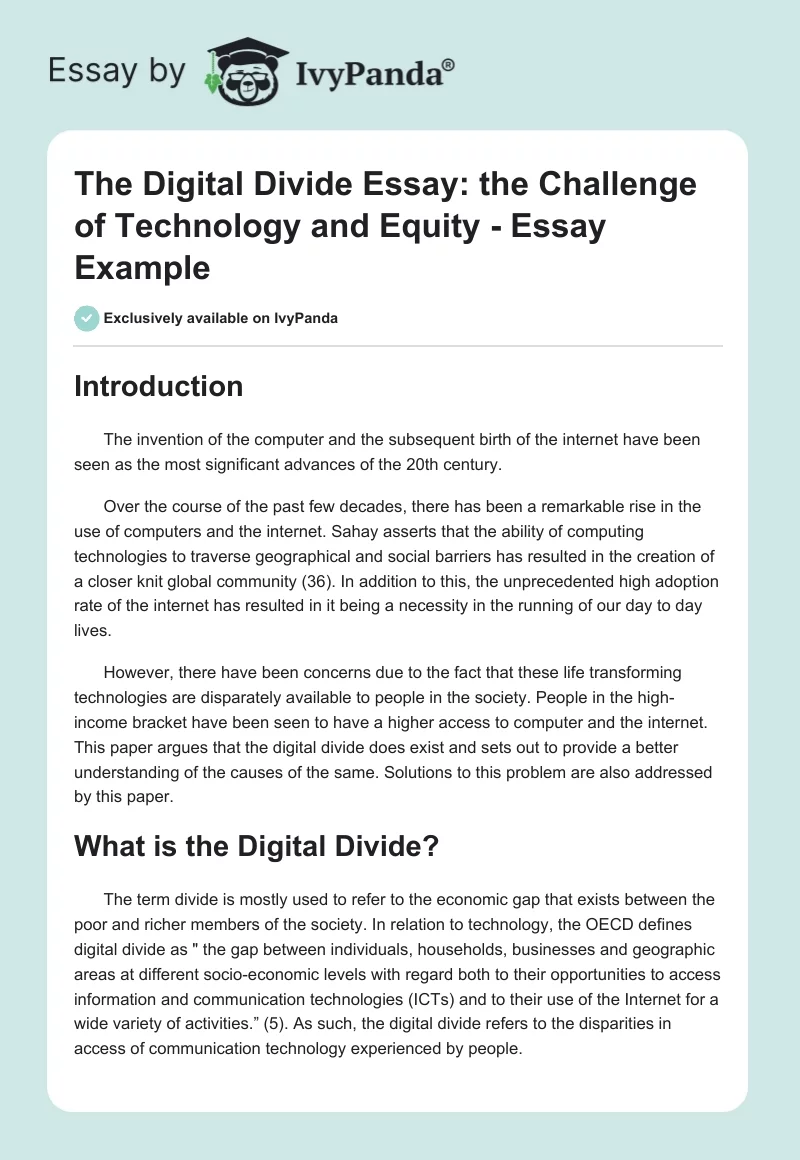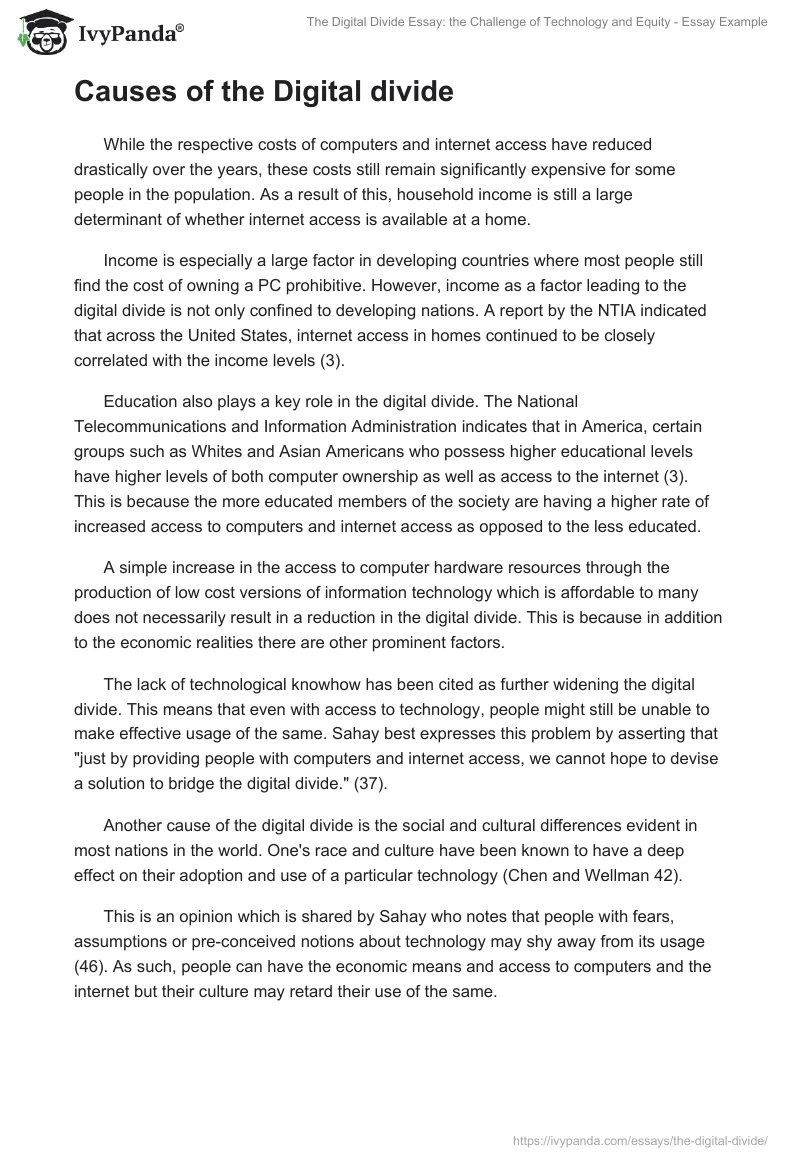Introduction
The invention of the computer and the subsequent birth of the internet have been seen as the most significant advances of the 20th century.
Over the course of the past few decades, there has been a remarkable rise in the use of computers and the internet. Sahay asserts that the ability of computing technologies to traverse geographical and social barriers has resulted in the creation of a closer knit global community (36). In addition to this, the unprecedented high adoption rate of the internet has resulted in it being a necessity in the running of our day to day lives.
However, there have been concerns due to the fact that these life transforming technologies are disparately available to people in the society. People in the high-income bracket have been seen to have a higher access to computer and the internet. This paper argues that the digital divide does exist and sets out to provide a better understanding of the causes of the same. Solutions to this problem are also addressed by this paper.
What is the Digital Divide?
The term divide is mostly used to refer to the economic gap that exists between the poor and richer members of the society. In relation to technology, the OECD defines digital divide as ” the gap between individuals, households, businesses and geographic areas at different socio-economic levels with regard both to their opportunities to access information and communication technologies (ICTs) and to their use of the Internet for a wide variety of activities.” (5). As such, the digital divide refers to the disparities in access of communication technology experienced by people.
Causes of the Digital divide
While the respective costs of computers and internet access have reduced drastically over the years, these costs still remain significantly expensive for some people in the population. As a result of this, household income is still a large determinant of whether internet access is available at a home.
Income is especially a large factor in developing countries where most people still find the cost of owning a PC prohibitive. However, income as a factor leading to the digital divide is not only confined to developing nations. A report by the NTIA indicated that across the United States, internet access in homes continued to be closely correlated with the income levels (3).
Education also plays a key role in the digital divide. The National Telecommunications and Information Administration indicates that in America, certain groups such as Whites and Asian Americans who possess higher educational levels have higher levels of both computer ownership as well as access to the internet (3). This is because the more educated members of the society are having a higher rate of increased access to computers and internet access as opposed to the less educated.
A simple increase in the access to computer hardware resources through the production of low cost versions of information technology which is affordable to many does not necessarily result in a reduction in the digital divide. This is because in addition to the economic realities there are other prominent factors.
The lack of technological knowhow has been cited as further widening the digital divide. This means that even with access to technology, people might still be unable to make effective usage of the same. Sahay best expresses this problem by asserting that “just by providing people with computers and internet access, we cannot hope to devise a solution to bridge the digital divide.” (37).
Another cause of the digital divide is the social and cultural differences evident in most nations in the world. One’s race and culture have been known to have a deep effect on their adoption and use of a particular technology (Chen and Wellman 42).
This is an opinion which is shared by Sahay who notes that people with fears, assumptions or pre-conceived notions about technology may shy away from its usage (46). As such, people can have the economic means and access to computers and the internet but their culture may retard their use of the same.
Reducing the Divide
The digital divide leads to a loss of the opportunity by many people to benefit from the tremendous economic and educational opportunities that the digital economy provides (NTIA 3). As such, the reduction of this divide by use of digital inclusion steps is necessary for everyone to share in the opportunities provided. As has been demonstrated above, one of the primary causes of the digital divide is the income inequality between people and nations.
Most developing countries have low income levels and their population cannot afford computers. To help alleviate this, programs have been put in place to reduce the cost of computers or even offer them for free to the developing countries. For example, a project by Quanta Computer Inc in 2007 set out to supply laptops to developing world children by having consumers in the U.S. buy 2 laptops and have one donated to Africa (Associated Press).
Studies indicate that males are more likely than females in the comparable population to have internet access at home mostly since women dismiss private computer and internet usage (Korupp and Szydlik 417). The bridging of this gender divide will therefore lead to a reduction in the digital divide that exists.
In recent years, there has been evidence that the gender divide is slowly closing up. This is mostly as a result of the younger generation who use the computer and internet indiscriminately therefore reducing the strong gender bias that once existed. This trend should be encouraged so as to further accelerate the bridging of the digital divide.
As has been illustrated in this paper, there exist non economic factors that may lead to people not making use of computers hence increasing the digital divide. These factors have mostly been dismissed as more attention is placed on the income related divide. However, dealing with this social and cultural related divides will also lead to a decrease in the divide. By alleviating the fears and false notions that people may have about technology, people will be more willing to use computers and the internet.
Digital Divide: Essay Conclusion
A divide, be it digital or economic acts as a major roadblock in the way for economic and social prosperity. This paper set out to investigate the digital divide phenomena. To this end, the paper has articulated the issue of digital divide, its causes and solutions to the problem.
While some people do suggest that the digital divide will get bridged on its own as time progresses, I believe that governments should take up affirmative action and fund projects that will result in a digitally inclusive society. Bridging of the digital divide will lead to people and nations increasingly being included in knowledge based societies and economies. This will have a positive impact to every community in the entire world.
Works Cited
Associated Press. Hundred-Dollar Laptop’ on Sale in Two-for-One Deal. 2007. Web.
Chen, Wenhong and Wellman, Barry. The Global Digital Divide- Within and Between Countries. IT & SOCIETY, VOLUME 1, ISSUE 7. 2004, PP. 39-45.
Korupp, Sylvia and Szydlik, Marc. Causes and Trends of the Digital Divide. European Sociological Review Vol. 21. no. 4, 2005.
National Telecommunications and Information Administration (NTIA). Falling Through the Net: Towards Digital Inclusion. 2000. Web.
Organization for Economic Cooperation and Development (OECD). Understanding the Digital Divide. 2001. Web.
Sahay, Rishika. The causes and Trends of the Digital Divide. 2005. Web.


